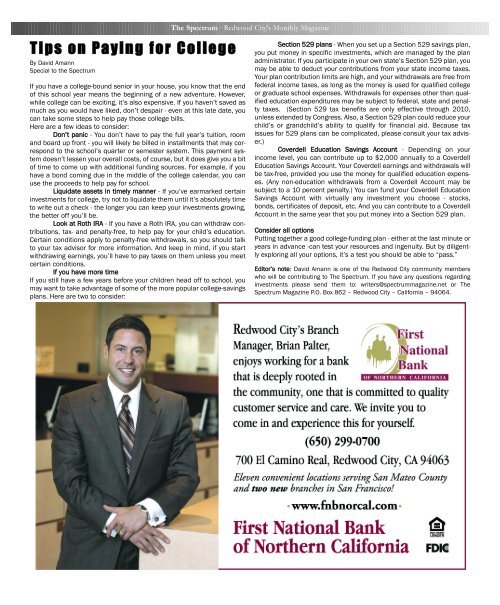Publisher - The Spectrum Magazine - Redwood City's Monthly ...
Publisher - The Spectrum Magazine - Redwood City's Monthly ...
Publisher - The Spectrum Magazine - Redwood City's Monthly ...
Create successful ePaper yourself
Turn your PDF publications into a flip-book with our unique Google optimized e-Paper software.
T i p s o n P a y i n g f o r C o l l e g e<br />
By David Amann<br />
Special to the <strong>Spectrum</strong><br />
If you have a college-bound senior in your house, you know that the end<br />
of this school year means the beginning of a new adventure. However,<br />
while college can be exciting, it’s also expensive. If you haven’t saved as<br />
much as you would have liked, don’t despair - even at this late date, you<br />
can take some steps to help pay those college bills.<br />
Here are a few ideas to consider:<br />
Don’t panic - You don’t have to pay the full year’s tuition, room<br />
and board up front - you will likely be billed in installments that may correspond<br />
to the school’s quarter or semester system. This payment system<br />
doesn’t lessen your overall costs, of course, but it does give you a bit<br />
of time to come up with additional funding sources. For example, if you<br />
have a bond coming due in the middle of the college calendar, you can<br />
use the proceeds to help pay for school.<br />
Liquidate assets in timely manner - If you’ve earmarked certain<br />
investments for college, try not to liquidate them until it’s absolutely time<br />
to write out a check - the longer you can keep your investments growing,<br />
the better off you’ll be.<br />
Look at Roth IRA - If you have a Roth IRA, you can withdraw contributions,<br />
tax- and penalty-free, to help pay for your child’s education.<br />
Certain conditions apply to penalty-free withdrawals, so you should talk<br />
to your tax advisor for more information. And keep in mind, if you start<br />
withdrawing earnings, you’ll have to pay taxes on them unless you meet<br />
certain conditions.<br />
If you have more time<br />
If you still have a few years before your children head off to school, you<br />
may want to take advantage of some of the more popular college-savings<br />
plans. Here are two to consider:<br />
<strong>The</strong> <strong>Spectrum</strong> . <strong>Redwood</strong> <strong>City's</strong> <strong>Monthly</strong> <strong>Magazine</strong><br />
Section 529 plans - When you set up a Section 529 savings plan,<br />
you put money in specific investments, which are managed by the plan<br />
administrator. If you participate in your own state’s Section 529 plan, you<br />
may be able to deduct your contributions from your state income taxes.<br />
Your plan contribution limits are high, and your withdrawals are free from<br />
federal income taxes, as long as the money is used for qualified college<br />
or graduate school expenses. Withdrawals for expenses other than qualified<br />
education expenditures may be subject to federal, state and penalty<br />
taxes. (Section 529 tax benefits are only effective through 2010,<br />
unless extended by Congress. Also, a Section 529 plan could reduce your<br />
child’s or grandchild’s ability to qualify for financial aid. Because tax<br />
issues for 529 plans can be complicated, please consult your tax adviser.)<br />
Coverdell Education Savings Account - Depending on your<br />
income level, you can contribute up to $2,000 annually to a Coverdell<br />
Education Savings Account. Your Coverdell earnings and withdrawals will<br />
be tax-free, provided you use the money for qualified education expenses.<br />
(Any non-education withdrawals from a Coverdell Account may be<br />
subject to a 10 percent penalty.) You can fund your Coverdell Education<br />
Savings Account with virtually any investment you choose - stocks,<br />
bonds, certificates of deposit, etc. And you can contribute to a Coverdell<br />
Account in the same year that you put money into a Section 529 plan.<br />
Consider all options<br />
Putting together a good college-funding plan - either at the last minute or<br />
years in advance -can test your resources and ingenuity. But by diligently<br />
exploring all your options, it’s a test you should be able to “pass.”<br />
Editor’s note: David Amann is one of the <strong>Redwood</strong> City community members<br />
who will be contributing to <strong>The</strong> <strong>Spectrum</strong>. If you have any questions regarding<br />
investments please send them to: writers@spectrummagazine.net or <strong>The</strong><br />
<strong>Spectrum</strong> <strong>Magazine</strong> P.O. Box 862 – <strong>Redwood</strong> City – California – 94064.

















